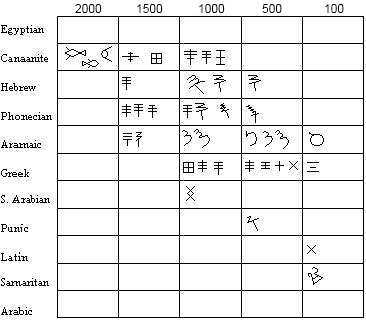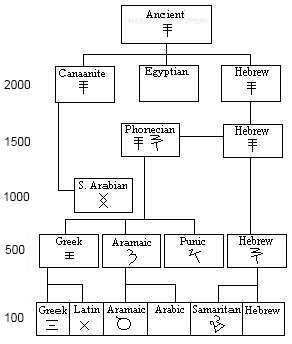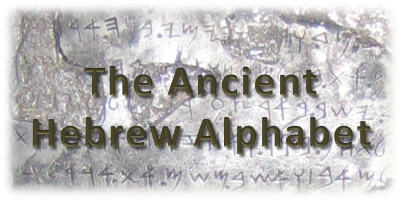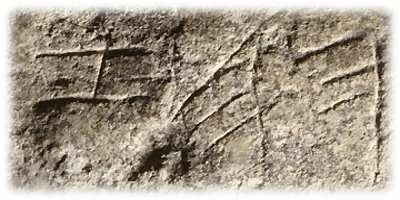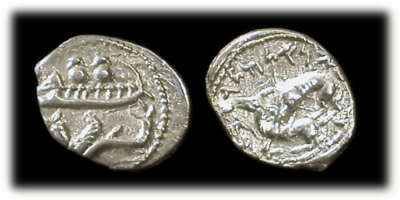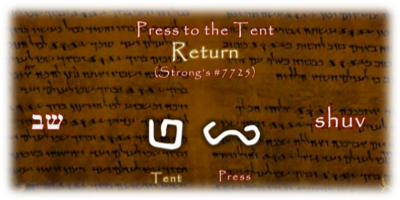History & Reconstruction
There are several possibilities for the original Semitic pictograph including  (a fish),
(a fish),  (possibly a thorn),
(possibly a thorn),  (a window?) and
(a window?) and  (a thorn). The pictograph
(a thorn). The pictograph  is used almost exclusively throughout the early and middle history of this letter. This picture has the meanings of "pierce" and "sharp." This letter also has the meaning of a shield, as thorn bushes were used by the shepherd to build a wall, or shield, to enclose his flock during the night to protect them from predators. Another meaning of this letter is to "grab hold" as a thorn clings to hair and clothing.
is used almost exclusively throughout the early and middle history of this letter. This picture has the meanings of "pierce" and "sharp." This letter also has the meaning of a shield, as thorn bushes were used by the shepherd to build a wall, or shield, to enclose his flock during the night to protect them from predators. Another meaning of this letter is to "grab hold" as a thorn clings to hair and clothing.
Of all the letters in the Hebrew alphabet, this is the most difficult to reconstruct due to its limited archeological and textual support. The Modern Hebrew name for this letter is samech, which is a word that means "support," with no apparent connection to a two letter parent root or to the meaning of the original picture of this letter. The Arabic alphabet does not have this letter and the Greek letter derived from this letter is called the ksi. The 21st letter of the Hebrew alphabet ש has two names and sounds, Shin (sh) and Sin (s). All the words using the sin are related in meaning to the words using a samech in the same place as the sin. It is possible that the original name for the samech was sin, which is the Hebrew word for a thorn, and at some point divided into two letters, the samech and sin and then the sin became associated with the letter shin.
The original sound for this letter must be an "s," to which the samech and sin both agree. The Greek sound for the letter is "ks," a sound that is similar to the "s."
The early Semitic  evolved into the
evolved into the  in the middle Semitic. This letter continued to evolve into
in the middle Semitic. This letter continued to evolve into  in the late Semitic. This letter became the ס in the Modern Hebrew alphabet. The Middle script became the Greek letter Ξ and the Greek letter became the Latin X.
in the late Semitic. This letter became the ס in the Modern Hebrew alphabet. The Middle script became the Greek letter Ξ and the Greek letter became the Latin X.
 (a fish),
(a fish),  (possibly a thorn),
(possibly a thorn),  (a window?) and
(a window?) and  (a thorn). The pictograph
(a thorn). The pictograph  is used almost exclusively throughout the early and middle history of this letter. This picture has the meanings of "pierce" and "sharp." This letter also has the meaning of a shield, as thorn bushes were used by the shepherd to build a wall, or shield, to enclose his flock during the night to protect them from predators. Another meaning of this letter is to "grab hold" as a thorn clings to hair and clothing.
is used almost exclusively throughout the early and middle history of this letter. This picture has the meanings of "pierce" and "sharp." This letter also has the meaning of a shield, as thorn bushes were used by the shepherd to build a wall, or shield, to enclose his flock during the night to protect them from predators. Another meaning of this letter is to "grab hold" as a thorn clings to hair and clothing.
 evolved into the
evolved into the  in the middle Semitic. This letter continued to evolve into
in the middle Semitic. This letter continued to evolve into  in the late Semitic. This letter became the ס in the Modern Hebrew alphabet. The Middle script became the Greek letter Ξ and the Greek letter became the Latin X.
in the late Semitic. This letter became the ס in the Modern Hebrew alphabet. The Middle script became the Greek letter Ξ and the Greek letter became the Latin X.
